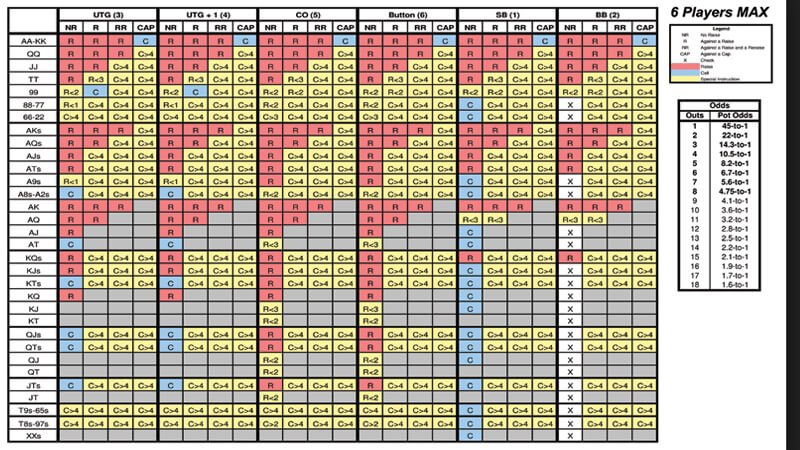No Limit Holdem Poker Odds
If you have 9 or fewer outs you should never be off by more than 2% in your calculations when using this rule and it's very rare to flop more than 9 outs in no-limit hold'em. That being said you probably don't want to make those calculations every single time and it's a very good idea to memorize some common situations that can occur at the tables.
It used to be that skilled poker players — who mostly played fixed-limit games — needed to learn how to adapt their games to no-limit once the NL hold'em 'boom' hit. Today, however, since most players at the tables now cut their teeth on no-limit, they've got to learn the old form of the game if they're going to become winning limit players.
Toward that end, with the availability of limit hold'em, H.O.S.E. and H.O.R.S.E. games online, and with casinos spreading limit games especially during major tournaments like the World Series of Poker in Las Vegas, it's useful to understand some key conceptual differences between the two formats.
In this article I'd like to focus on the most significant difference between no-limit and fixed-limit games — implied odds. Then in a follow-up we'll talk further about some of the other most important adjustments players need to make when moving from no-limit to limit.
Pot Odds, Drawing Odds and Implied Odds

In no-limit poker implied odds are hugely important, while in fixed-limit games the significance of implied odds is, well, limited.
For those of you not familiar with the term, a quick primer on 'pot odds,' 'drawing odds' and 'implied odds' is necessary.
'Pot odds' refers to the amount of money you may win when you call a bet compared to the cost of calling that bet. If there's $800 in the pot and your opponent bets $200, to call means paying $200 with a chance at winning $1,000 total — in other words, you're getting 5-to-1 pot odds with your call.
Texas Hold'em Poker Odds Chart
'Drawing odds' refers to the probability that you won't make your hand. If you're drawing to a flush on the river, your drawing odds are the total number of unseen cards that don't help your hand compared to the number of cards that will give you the flush. Specifically, out of the total of 46 unseen cards, the odds are 37-to-9 or a little worse than 4-to-1 against you making your flush.
Finally, 'implied odds' are the pot odds as calculated above but also adding the money you might win on future betting rounds, too. Say you had that flush draw and faced having to call a bet on the turn. You'd calculate your pot odds, but add in the amount you might also win on the river if you hit your flush and bet and your opponent called. In a no-limit game, you could potentially win the size of your opponent's stack on the river (assuming you have him covered). Meanwhile in a limit game, you're only considering the size of another 'big bet' (the higher tier of betting) when thinking about implied odds — e.g., $20 in a $10/$20 limit game.
Without considering implied odds, if you are getting better pot odds than the drawing odds, then you should call. But if you're getting worse drawing odds than pot odds, then you aren't getting a good enough price for your call and you should fold.
If, for example, there was only $200 in the pot and your opponent bet $200 on the turn, then you'd only be getting $400 for your $200 call — that's 2-to-1 pot odds. Since your odds of hitting the flush on the river of worse than 4-to-1, that would be a bad call and you should fold.
But implied odds includes an additional piece of information to consider — the amount you might win on the river as well. Implied odds compares the cost of your bet on the turn with the total amount you might win in the hand, including the river.
So in the example above, with a pot of $200 on the turn, and a bet of $200 from your opponent, you'd have to know how much money you each had left in your stacks to know the implied odds. If you each had another $1,000 behind, and you thought your opponent would call off his entire stack if you bet it on the river after hitting your flush, then your implied odds would not be just 2-to-1, but rather 7-to-1 — the $400 pot on the turn plus the additional $1,000 you expected to win on the river if you hit your flush and your opponent called your stack-sized bet.
Texas No Limit Hold'em Poker
It should be added that implied odds are often going to be an estimate and not an exact calculation as with simple pot odds. If you know your opponent will call off his entire stack on the river when you make your flush and go all in, then you can be precise about the implied odds. But sometimes you'll only be able to estimate how much an opponent might pay off in such a spot (e.g., sizing your bet effectively to earn the call, not betting too much and having an opponent fold), which means you can't always be quite as exact with implied odds.

Implied Odds: Limit vs. No-Limit
Since players can potentially commit their entire stacks at any point in a no-limit poker hand, implied odds are especially important. There are implied odds in limit poker, too, of course — but they have less significance thanks to the limits on betting.
Continuing with the example of your drawing to a flush with one card to come, if the game were $100/$200 limit hold'em, you would factor in the chances that you could win one extra $200 bet on the river. So if the pot were $400 at the start of the turn and your opponent bet $200 (making the pot $600), you'd have immediate pot odds of 3-to-1 for your $200 call. That alone is not enough to justify continuing with your flush draw (which is a little worse than 4-to-1 of hitting).
But if you considered your implied odds, and figured your opponent would call your bet 100 percent of the time if you hit your flush on the river, you could add another $200 to what you stand to win as you decide whether to call that turn bet, giving you pot odds of 4-to-1 — closer to your drawing odds, but still not really making the call worthwhile.
Implied odds aren't just applicable on the turn and river. They are to be considered right from your initial decision to play your two hole cards. In no-limit games especially, implied odds have to be kept in mind as you are potentially 'playing for stacks' in every hand. That's not generally the case in fixed-limit games, which leads to many other strategic differences, including...
- playing more selectively preflop
- knowing when and how to press your advantages (extracting extra bets)
- being selective with postflop play
- making more river calls
- check-raising more frequently
I'll explore all five of these adjustments in more detail in the next article.
Ashley Adams has been playing poker for 50 years and writing about it since 2000. He is the author of hundreds of articles and two books, Winning 7-Card Stud (Kensington 2003) and Winning No-Limit Hold'em (Lighthouse 2012). He is also the host of poker radio show House of Cards. See www.houseofcardsradio.com for broadcast times, stations, and podcasts.
Be sure to complete your PokerNews experience by checking out an overview of our mobile and tablet apps here. Stay on top of the poker world from your phone with our mobile iOS and Android app, or fire up our iPad app on your tablet. You can also update your own chip counts from poker tournaments around the world with MyStack on both Android and iOS.

Tags
cash game strategytournament strategyfixed-limit hold’emlimit hold’emno-limit hold’emimplied oddspot oddsdrawing handspreflop strategypostflop strategy